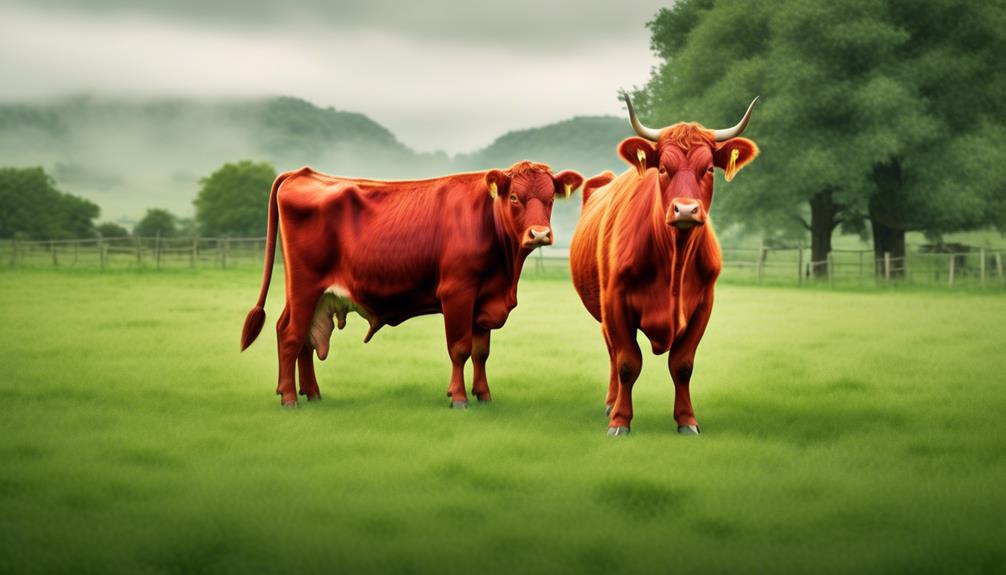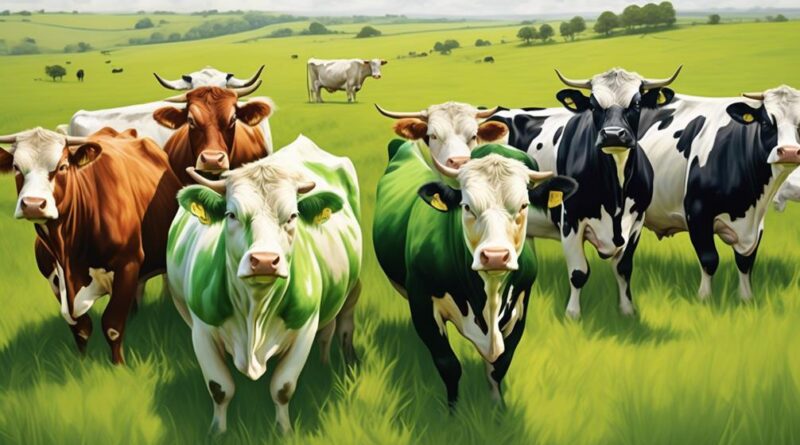Top Grass-Fed Cattle Breeds for Superior Marbling
You've probably heard that the key to exceptional marbling in grass-fed cattle lies in the choice of breed. But with so many options out there, it can be overwhelming to determine which ones truly stand out.
However, fear not, because we're here to shed light on the top grass-fed cattle breeds that are renowned for their superior marbling. From the well-known Angus to the highly prized Wagyu, there's a breed to suit every discerning palate.
But what makes these breeds so special? Stay tuned to discover the fascinating characteristics that set them apart and make them the top contenders for achieving superior marbling in grass-fed beef.
Angus
If you're looking for a popular and well-known breed of grass-fed cattle, Angus is a top choice due to its marbling and tender meat. Angus cattle are renowned for their exceptional meat quality characteristics, making them a favorite among beef enthusiasts.
The breeding techniques for Angus are crucial in maintaining and enhancing their desirable traits. Angus are often bred using selective mating to ensure the continuation of their superior genetics. This selective breeding focuses on traits such as marbling, tenderness, and overall meat quality, resulting in a consistent and high-quality product.
Angus meat quality characteristics are highly sought after in the beef industry. The meat from Angus cattle is well-known for its marbling, which refers to the intramuscular fat that enhances the flavor and tenderness of the meat. This marbling is a result of the breeding techniques that prioritize this particular trait.
Additionally, Angus beef is known for its excellent tenderness, juiciness, and rich flavor, making it a top choice for steaks and other premium beef cuts.
Wagyu
Renowned for its exceptional marbling and tenderness, Wagyu cattle are a highly sought-after breed for their superior meat quality. Wagyu marbling techniques play a pivotal role in achieving the unparalleled quality of Wagyu beef. The unique genetic predisposition of Wagyu cattle, combined with specific feeding and care techniques, contributes to the intricate marbling that sets Wagyu beef apart. Wagyu cattle are meticulously raised and often fed a special diet that includes high-quality grains and grasses, which further enhances the marbling of the meat.
In recent years, the Wagyu beef market has experienced notable trends. Demand for Wagyu beef has surged globally, driven by an increasing appreciation for its exceptional quality and flavor. As a result, many cattle farmers have started to incorporate Wagyu genetics into their herds to capitalize on this trend. Furthermore, there's been a growing interest in authentic Wagyu beef, particularly from specific regions in Japan renowned for producing the highest quality Wagyu. This has led to an expansion of Wagyu breeding programs around the world, aiming to emulate the superior marbling and taste for which authentic Japanese Wagyu is revered.
Hereford
The Hereford breed of cattle is known for its distinctive red and white coloring and is widely recognized for its adaptability to various climates and grazing conditions. Hereford cattle are popular for their excellent meat quality characteristics, making them a top choice for grass-fed beef production. When it comes to hereford breeding practices, the emphasis is on selecting for marbling, tenderness, and flavor in the meat. Hereford cattle are carefully bred to enhance these desirable meat qualities, ensuring a superior end product for consumers.
Hereford cattle are known for their ability to efficiently convert grass into well-marbled, flavorful beef. This makes them an excellent choice for grass-fed operations, as they thrive on grazing and produce high-quality, marbled meat. The meat from Hereford cattle is prized for its tenderness, juiciness, and rich beefy flavor. These meat quality characteristics are a result of selective breeding and a focus on maintaining the breed's natural attributes that contribute to superior beef quality.
In Hereford breeding practices, there's a concerted effort to preserve and enhance the breed's genetic predisposition for marbling and palatability. By carefully selecting breeding stock with superior meat quality characteristics, Hereford producers are able to consistently deliver beef with exceptional marbling and flavor. This dedication to breeding practices ensures that Hereford cattle continue to be a top choice for grass-fed beef production, providing consumers with a premium dining experience.
Shorthorn
Shorthorn cattle, like Hereford, are known for their adaptability and excellent meat quality, making them a valuable choice for grass-fed beef production. When considering Shorthorn for your grass-fed cattle operation, it's important to understand their key characteristics and meat quality:
- Adaptability: Shorthorn cattle are renowned for their adaptability to various climates and grazing conditions. They can thrive in a range of environments, making them well-suited for grass-fed beef production in diverse geographical areas. This adaptability can provide peace of mind for cattle farmers, knowing that their animals can withstand different environmental challenges.
- Meat Quality: Shorthorn beef is prized for its exceptional marbling, tenderness, and rich flavor profile. The well-distributed marbling results in juicy, flavorful beef that's highly sought after by consumers. This superior meat quality can lead to premium pricing and increased demand for grass-fed Shorthorn beef products.
- Efficient Feed Conversion: Shorthorn cattle are known for their efficient feed conversion, meaning they can efficiently convert grass into high-quality beef. This efficiency can lead to cost savings for cattle producers and contribute to the sustainability of grass-fed beef operations.
Charolais
Consider choosing Charolais for your grass-fed cattle operation due to their impressive growth rates and lean meat quality, which are highly valued in the beef industry.
Charolais, a French breed, is renowned for its exceptional growth rate and efficiency in converting grass into high-quality lean meat. The breed is characterized by its well-muscled frame, broad back, and strong bone structure, making it an ideal choice for grass-fed operations aiming for superior meat quality.
Charolais cattle are known for their exceptional marbling quality, which is a crucial factor in determining the tenderness, juiciness, and flavor of beef. The breed's ability to develop marbling even on a grass-fed diet sets it apart from other cattle breeds. This marbling not only enhances the taste and tenderness of the meat but also contributes to its overall quality, making it highly sought after in the market.
In addition to their marbling quality, Charolais cattle exhibit excellent feed efficiency, allowing them to thrive on grass-fed diets while still achieving desirable weight gains. This efficiency makes them a cost-effective choice for grass-fed operations, as they can efficiently convert forage into high-quality beef. Moreover, their lean meat quality aligns with the increasing consumer demand for healthier, leaner beef options.
Limousin
Wondering what sets Limousin apart as a grass-fed cattle breed? Here's what you need to know about the Limousin breed characteristics and its marbling potential:
- Muscular Build: Limousin cattle are known for their muscular build, which contributes to their lean meat production. Their well-developed hindquarters and shoulders make them efficient converters of grass into high-quality beef.
- Efficient Feed Conversion: Limousin cattle are highly efficient at converting grass into lean muscle, making them ideal for grass-fed operations. Their ability to thrive on forages results in beef with excellent texture and flavor.
- Marbling Potential: While Limousin cattle are renowned for their leanness, they also possess the potential for good marbling. When managed under the right conditions, such as a balanced forage diet and proper finishing, Limousin beef can exhibit desirable marbling, adding to its tenderness and flavor.
In terms of Limousin marbling potential, it's important to note that while this breed is traditionally known for its leanness, careful management and feeding practices can enhance the marbling in their beef. By leveraging their efficient feed conversion and muscular build, Limousin cattle can produce high-quality, marbled beef while maintaining their characteristic leanness.
Red Devon

Red Devon, another notable grass-fed cattle breed, shares the efficient feed conversion and potential for marbling that Limousin cattle are known for. The Red Devon breed has a rich genetic history that traces back to the southwestern region of England. These cattle are known for their ability to thrive on grass and convert it into high-quality beef, making them an excellent choice for grass-fed operations.
When it comes to meat quality, Red Devon cattle are highly regarded for their superior marbling, tenderness, and rich flavor. The breed's genetic predisposition for marbling makes its beef highly sought after in the culinary world. The well-marbled meat not only enhances the flavor but also contributes to the juiciness and overall eating experience, making it a top choice for discerning consumers and chefs alike.
Red Devon cattle's genetic history has played a significant role in shaping their desirable meat quality. Over generations, careful breeding practices have honed the breed's ability to produce well-marbled, flavorful beef that meets the high standards of grass-fed beef enthusiasts. Whether it's a juicy steak or a tender roast, the meat from Red Devon cattle continues to impress with its exceptional quality and flavor, making it a prized choice for those seeking top-notch grass-fed beef.
South Devon
Originating from the southwestern region of England, South Devon cattle have gained recognition for their robust nature and adaptability to grass-fed environments. These cattle are known for their distinct characteristics and high-quality marbling, making them an excellent choice for grass-fed beef production.
South Devon Breed Characteristics
- Adaptability: South Devon cattle are highly adaptable to various climates and terrains, allowing them to thrive in different grass-fed environments.
- Docile Temperament: Their calm and docile nature makes handling and management easier, contributing to a more stress-free environment for both the animals and the handlers.
- Efficient Growth: South Devon cattle are renowned for their rapid growth rates, efficient feed conversion, and high fertility, making them a valuable asset in grass-fed operations.
South Devon Marbling Quality
South Devon cattle are prized for their exceptional marbling quality. The intramuscular fat distributed throughout the meat results in superior tenderness, juiciness, and flavor. This high marbling quality is a key factor in producing premium grass-fed beef that meets the standards of discerning consumers and chefs.
Frequently Asked Questions
How Do Grass-Fed Cattle Breeds Compare to Grain-Fed Cattle Breeds in Terms of Marbling and Flavor?
When comparing grass-fed and grain-fed cattle breeds, grass-fed cattle generally have less marbling than grain-fed. The flavor of grass-fed beef is often described as leaner and earthier, while grain-fed beef tends to be juicier and have a richer taste.
Are There Specific Environmental Factors That Can Impact the Marbling of Grass-Fed Cattle Breeds?
Environmental factors, such as grazing conditions and pasture-raised duration, can influence the marbling of grass-fed cattle breeds. Genetic predisposition also plays a role in determining the marbling quality of the meat.
What Are the Main Differences in Marbling and Meat Quality Between the Various Grass-Fed Cattle Breeds Mentioned in the Article?
When it comes to marbling differences and meat quality variations among grass-fed cattle breeds, it's essential to consider factors like genetics, diet, and age. These elements impact the texture, flavor, and tenderness of the meat.
Are There Any Specific Challenges or Considerations When Raising Grass-Fed Cattle of These Breeds Compared to Grain-Fed Cattle?
Raising grass-fed cattle breeds brings challenges and considerations compared to grain-fed cattle. Nutritional requirements differ, grazing practices need adjustment, and breed-specific traits may affect marbling. Overcoming these hurdles can lead to superior quality beef.
Can the Marbling of Grass-Fed Cattle Breeds Be Influenced by the Type of Grasses They Consume or the Length of Time They Are Pasture-Raised?
Yes, the marbling of grass-fed cattle breeds can be influenced by the type of grasses they consume, grazing duration, and nutritional content. Breeding practices also play a role in enhancing marbling quality.
Conclusion
So when it comes to choosing grass-fed cattle breeds for superior marbling, consider the Angus, Wagyu, Hereford, Shorthorn, Charolais, Limousin, Red Devon, and South Devon.
These breeds are known for their high-quality marbling, which results in tender and flavorful meat.
By selecting the right breed for your grass-fed cattle, you can ensure a superior product that meets the demands of discerning consumers.
